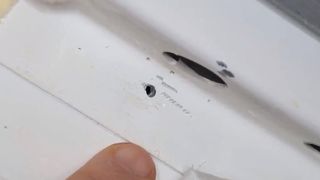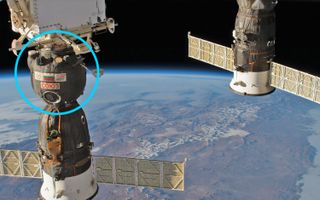Russian space officials try to blame NASA astronaut for Soyuz air leak in 2018: report
NASA says the accusations are baseless.

CAPE CANAVERAL, Fla. — NASA's head of human spaceflight says the agency stands behind its astronauts following claims that a U.S. crewmember at the International Space Station sabotaged a Russian Soyuz spacecraft in 2018, causing an air leak at the orbiting laboratory.
On Friday afternoon (Aug. 13), during a media teleconference about recent delays with Boeing's Starliner spacecraft, NASA's human spaceflight chief Kathy Lueders told reporters that the personal attacks against NASA astronaut and Expedition 56 flight engineer Serena Auñón-Chancellor were baseless.
"Serena is an extremely well-respected crew member who has served her country and made invaluable contributions to the agency," Lueders told reporters. "And I stand behind Serena — we stand behind Serena and her professional conduct and I did not find this accusation credible."
Related: Space Station commander: It's 'absolutely a shame' to suggest astronauts caused air leak
Lueders expressed those same sentiments on Twitter Friday afternoon, with NASA's administrator, Senator Bill Nelson agreeing.:
"I wholeheartedly agree with Kathy's statement," Nelson tweeted. "I fully support Serena and I will always stand behind our astronauts."
Russian accusations
NASA leadership's statements on Friday follow on the heels of accusations from an unnamed "high-ranking" official with Russia's space agency made in the Russian news agency TASS. The agency claims that in 2018, Auñón-Chancellor had an emotional breakdown in space and then damaged a Russian Soyuz spacecraft that was docked at the station so that she could return to Earth early.
Get the Space.com Newsletter
Breaking space news, the latest updates on rocket launches, skywatching events and more!
The article, published on Thursday (Aug. 12), responds to criticism from U.S. media in regards to the near-disastrous incident involving Russia's Nauka science module and the International Space Station (ISS) earlier this month.
Related: Space station situation with Russia's Nauka module misfire was more serious than stated

In the TASS article, Russian journalist Mikhail Kotov interviews an anonymous official at Russia's space agency, Roscosmos.
The article is particularly troublesome because it not only names Auñón-Chancellor — the only female astronaut on station at the time — specifically, but it also reveals a medical condition she suffered on-orbit. (Typically NASA keeps all astronaut medical records and conditions private.)
Auñón-Chancellor was treated upon her return to Earth for a deep vein thrombosis, also known as a blood clot, in the jugular vein of her neck. But Kotov implies that dealing with such a condition in space could spur her to want to leave the ISS prematurely, and therefore sabotage the spacecraft that brought her to the orbital outpost in an effort to return home ahead of schedule.
Leaky Soyuz
On Aug. 29, 2018, ISS controllers at NASA's Johnson Space Center in Houston noticed a slight pressure drop aboard the orbiting outpost. They notified the crew the next day, and the crew was able to trace the leak to a small hole in Russia's Soyuz MS-09 spacecraft, which had docked to the space station in June with Auñón-Chancellor, European Space Agency astronaut Alexander Gerst and Russian cosmonaut Sergey Prokopyev.
Prokopyev, the commander of the Soyuz at the time, solved the problem by patching the 2-millimeter (0.08 inches) hole using epoxy and gauze. NASA officials stressed that the crew was never in any danger.
Russian space officials decided to investigate the leak, determined to find out its cause. Shortly thereafter, Dmitry Rogozin — the head of Roscosmos — announced that the breach in the Soyuz wall was a drill hole. And according to Rogozin, the person who made the hole apparently had "a faltering hand," citing nearby scuff marks that likely resulted when the drill slipped.
Russian officials went one step further insinuating that the unsteady hand was likely due to the culprit drilling in microgravity, meaning one of the crew was to blame — not the Russian engineers involved in the assembly and testing of the Soyuz spacecraft before launch down on Earth.

NASA officials knew the precise locations of the U.S. astronauts before the leak occurred and at the moment it began, thanks to space station surveillance. The video footage indicated that none of the U.S. astronauts on the station were near the Russian segment where the Soyuz vehicle was docked. But the Russians didn't buy it. They were convinced that one of the crew sabotaged the Soyuz.
The recent TASS article takes those claims one step further and insists that NASA video of the ISS could have been tampered with and that Russian officials were denied the chance to examine Russian tools and administer polygraphs, or lie detector tests, to the astronauts.
But the TASS article seems to dismiss the most likely cause of the hole: human error on the ground. The problem most likely happened on Earth, before launch. This was something that Roscosmos was looking into but the agency has never definitively disclosed the results.
Most likely a technician accidentally damaged the Soyuz spacecraft and then tried to cover up the error with a makeshift patch. That patch could have then become dislodged during flight or its time on-orbit after repeated exposure to extreme temperature differences as the station orbits the Earth.
Looking ahead
Relations between the two space agencies have grown more strained over recent years, but NASA leadership is hopeful for a continued orbital partnership.
Prior to the launch attempt of Boeing's Starliner spacecraft on July 30, Nelson told Space.com that he applauded the long-standing relationship between the two agencies. "Terrestrially, we have enormous tensions with Russia, but in space we have cooperation."
Nelson also said that he expects Russia will continue to work with NASA to maintain the ISS and that he hopes to announce sometime soon that a cosmonaut will fly on an upcoming SpaceX Crew Dragon flight, something the agency has been trying to arrange for quite some time.
Perhaps cosmonauts will make their U.S. commercial spaceflight debut with the SpaceX Crew-4 mission, currently slated to launch in2022, Nelson has said, but nothing is confirmed yet.
Follow Amy Thompson on Twitter @astrogingersnap. Follow us on Twitter @Spacedotcom or Facebook.
Join our Space Forums to keep talking space on the latest missions, night sky and more! And if you have a news tip, correction or comment, let us know at: community@space.com.

Amy Thompson is a Florida-based space and science journalist, who joined Space.com as a contributing writer in 2015. She's passionate about all things space and is a huge science and science-fiction geek. Star Wars is her favorite fandom, with that sassy little droid, R2D2 being her favorite. She studied science at the University of Florida, earning a degree in microbiology. Her work has also been published in Newsweek, VICE, Smithsonian, and many more. Now she chases rockets, writing about launches, commercial space, space station science, and everything in between.
